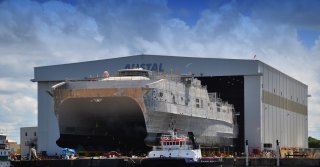Expeditionary Fast Transports: The Navy’s High-Speed Delivery Vessel
The speed and capacity of the Expeditionary Fast Transports allow them to support several operations crucial to maritime strategies.
The Navy’s Expeditionary Fast Transport (EPF) ability to maneuver at high speeds while carrying heavy equipment brings clear advantages to maritime combat. The EPFs range of 1,200 miles allows the Navy to execute transport missions without operating larger, deeper-draft vessels in high-risk areas.
The EPFs can also support the Navy’s Distributed Maritime Operations concept. The strategy aims to leverage long-range sensors, networking, and new weapons applications to optimize combat effectiveness by operating disaggregated forces on the ocean.
Once a beachhead is secured through an amphibious attack, for example, arriving forces will need reinforcements to achieve mission objectives. These ships also help sea-basing objectives by enabling transport from the ocean, removing the need for land deployments in high-risk, difficult-to-reach areas. Larger, deeper-draft ships will be able to operate at much safer distances, while EPFs approach enemy areas as smaller, faster, and less vulnerable targets.
While operating at sea, attacking forces can be better safeguarded and supported by airpower. Big-deck amphibious ships or aircraft carriers could be positioned to support advancing attack forces moving on land if platforms such as F-35 Lightning II fighter jets, V-22 Osprey tiltrotor aircraft, or F/A-18 Super Hornets have targeting and logistics support from the shore.
Special Operations Forces also often need to move quickly in smaller groups. However, they may also need supplies, weapons, equipment, and even platforms such as fast-moving tactical vehicles. The EPF may be able to support these operations, either by offloading men and equipment directly or launching rigid hull inflatable boats.
An Osprey launched from an amphibious ship or offshore base may deploy Marines behind enemy lines to gather intelligence, support friendly troops, or launch covert attacks. A nearby EPF could reinforce those troops after they deploy by quickly providing additional men or equipment.
Kris Osborn is the defense editor for the National Interest. Osborn previously served at the Pentagon as a Highly Qualified Expert with the Office of the Assistant Secretary of the Army—Acquisition, Logistics & Technology. Osborn has also worked as an anchor and on-air military specialist at national TV networks. He has appeared as a guest military expert on Fox News, MSNBC, The Military Channel, and The History Channel. He also has a Master’s Degree in Comparative Literature from Columbia University.
Image: U.S. Navy Flickr

